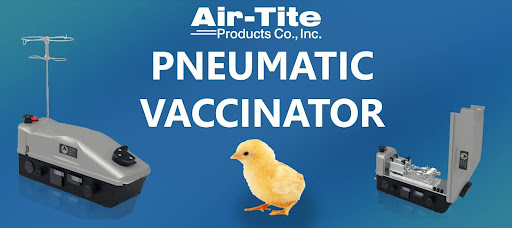
Better poultry vaccination methods promise to reduce losses as well as improve health outcomes. There are many different techniques to administer a vaccine to poultry flocks. Most are specific to the age of the bird that needs to be vaccinated. Some common administration practices include mass vaccination of a flock via drinking water, spray/nebulizing (at day of age), administering eye drops, delivery by transfixion and scarification (cutaneous route in the wing web or foot), injection through intramuscular or subcutaneous route, and In-Ovo administration.
If you are a hatchery looking to vaccinate your chicks at the day-old stage, what method of vaccination is most suitable for you? Hatcheries operate seasonally, and the process is time-sensitive (The spring hatching season is between February and April, and the fall season generally begins in September). It is crucial one chooses the most effective method, taking into consideration the time needed to perform the vaccinations during the optimal window. Other factors to consider when choosing a vaccination method are your experience level, the size of your hatchery and your vaccine administration team, and the number of day-old chicks you intend to vaccinate. The two best options would likely be a handheld reusable syringe for smaller amounts of birds or an automatic vaccinator for larger quantities.
What classifies a hatchery size and tool for vaccination is ultimately up to each hatchery. In general, it is feasible for a small to mid-sized hatchery to administer single accurate vaccine doses using a handheld device such as an ECO-MATIC® or an UNI-MATIC®. These devices are offered in multiple sizes, and options of a bottle mount or a tubing version (connecting the device to the cavity which holds the vaccine via arm or hip belt). A mid-size hatchery would require the ability to vaccinate roughly 3,500-4,000 baby chicks per week, and a large hatchery needs higher vaccination rates of 3,500-4,000 chicks per hour.
If production volume exceeds the ability to dose these vaccines manually, an automatic vaccinator would prove more beneficial. Some of the advantages include exceptional precision, enhanced safety, and improved productivity. If your hatchery requires dosing one vaccine, the PNEUMATIC VACCINATOR “Single” would be sufficient. The advantage of the PNEUMATIC VACCINATOR “Double” would be the ability to dose two vaccines with just one injection (it can still function as a single-dosing vaccinator when necessary). Whether single or double, this pneumatically driven automatic vaccinator applies poultry vaccines to day-old chicks, offering settings for subcutaneous (SC) and intra-muscular (IM) injections.
Now that we have identified options for vaccinating day-old chicks, and what would constitute using an automatic vaccinator, you might ask, how is it used? If you are new to the concept of an automatic vaccinator or seeking the best choice for your hatchery, there are great resources and support available (Watch the video on YouTube). It is important to note that this pneumatic vaccinator is specific to the vaccination of day-old chicks, as the needle size and injection distance are adjusted for this application. To operate the device, chicks are placed manually in the correct position to receive the vaccinator needle. The vaccine is applied pneumatically to the chick to achieve the correct dosage and depth. The system includes two settings, one for subcutaneous (SC) injections in the neck, and one for intramuscular (IM) injections in the leg of the chick. An integral counter calculates the total number of birds vaccinated, while a separate batch counter registers batch-specific numbers. The vaccinator uses compressed air and has an air filter to ensure the use of clean air every time. It is ideally used in combination with the vaccination carousel for fully optimized operator comfort. Weighing about 22 pounds, it is specially designed to improve reaction speed and ergonomics. Skilled personnel can achieve vaccination rates of up to 4,000 chicks per hour. It also enables the highest dosing accuracy for the vaccination of day-old chicks. Due to an adjustable trigger element, non-corrosive double-stroke cylinders, and high-quality components, the device offers everything you need in the hatchery: fatigue-proof and continuous usage.
At Air-Tite Products, we value being able to provide high-quality products for specialty uses, and we are happy to help our customers find customized solutions. Use the links below to explore our poultry products or contact us with any questions you have regarding syringes and vaccinators for poultry use.